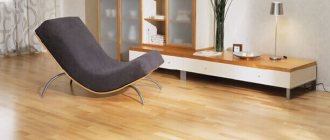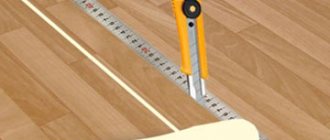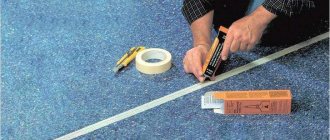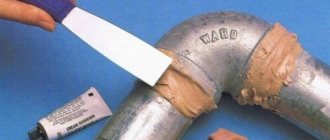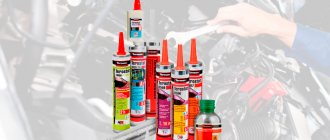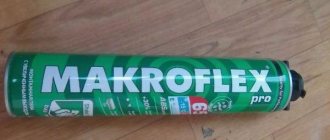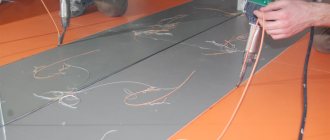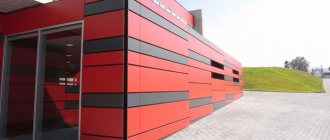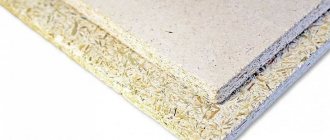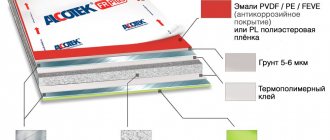Linoleum has remained a popular floor covering for many years due to its low cost, large selection of colors, durability and practicality. In addition, this material is low maintenance and quite easy to install, and if you need to join several panels, you can independently use cold welding for linoleum.
What it is
Cold welding of floor coverings is a chemical method of joining materials that does not involve the high temperatures associated with conventional welding.
The adhesive composition, entering into a polymerization reaction with the linoleum material, dissolves and melts the edges of the canvases. Their plastic deformation occurs. After completing the process of interaction of the mixture with the coating, a strong seam is formed at the joints of the sheets, and the structure is uniform in structure with the material being joined.
With a high-quality connection of the canvases, the joining seam is not noticeable.
The popularity of using adhesives for joining linoleum cloths of the “cold welding” type is due to the ease of working with them, the relative low cost and the versatility of the method.
Types of sheet gluing
Nowadays, two main types of gluing are used. The first of these is cold welding, when each part of the material is laid out exactly according to the intended dimensions in its place and then glued together. After this, glue the next line as tightly as possible to the previous one. This continues until the entire floor surface is covered. It uses colorless glue, which allows you to make seams in which no joining materials will be visible.
The second method is hot welding. Naturally, this is not ordinary metal welding, but it is closer to it than the previous version. This method is more often used on an industrial scale. Here the heat treatment of the edges of the linoleum takes place, which is carried out at 400 degrees Celsius. During this treatment, a special cord is sewn inside the sheet, thanks to which the ends of the material are securely connected. After inserting the cord, the seam is smoothed out so that it becomes extremely invisible.
Compound
The typical chemical composition of reactive adhesives is simplistically a mixture of solvent and filler. The concentration of these two components determines the type and technology of work.
Solvent
The following can be used as a solvent in compounds for polyvinyl chloride coating:
- Tetrahydrofuran is a compound from the ether family. It can account for up to 80% of the total volume of the mixture.
- Acetone is a common ingredient in adhesive mixtures that have fast-setting properties.
Given the good solvent properties of acetone, it can be used to make glue at home.
Finely chopped pieces of old linoleum without a base are poured with this solvent and left for at least a day until a homogeneous consistency is obtained.
Glue made from solvent and linoleum residues
But it should be borne in mind that such glue will be significantly lower in quality than factory mixtures that contain special fillers.
Adhesive
Various additives serve as additives for adhesive fillers in mixtures intended for soldering linoleum:
- plasticizers;
- polyvinyl chloride;
- polyurethane;
- PSH-LS resins.
Pigments and modifiers can also be added to the adhesive mixture. Some manufacturers, for reasons of trade secrets, do not advertise information about component substances.
Top 2. TANGIT EPOXY-LOCK
Rating (2021): 4.58
The best combination of price and quality German cold welding TANGIT EPOXY-LOCK is characterized by high frost resistance, adhesion, and resistance to aggressive environments. The glue is relatively inexpensive, demonstrating the best price-to-product capabilities ratio.
- Characteristics
Average price: 250 rub.
- Country: Germany
- Weight: 48 g
- Curing time: 70 min.
- Temperature resistance: -40…+110˚C
- Number of components: 2
Once the TANGIT EPOXY-LOCK two-component cold seal mixture is prepared for application, the user only has 3 minutes. High adhesion makes it easy to manually repair leaks in water pipes and heaters without blocking the lines. Universal glue is quite environmentally friendly, as it does not contain solvents. Users like that after hardening, the composition holds the glued parts (wood, plastic, metal, concrete, etc.) at -40˚C, and is impervious to water, solvents, oils and gasoline. The disadvantage is that it will not work with materials such as polypropylene and Teflon.
Advantages and disadvantages
- Can work on wet surfaces
- Sets quickly
- Frost-resistant
- Doesn't stick to polypropylene
See also:
- 12 best wood glues
Types of cold welding for linoleum
There are three main types of compositions for non-thermal joining of linoleum - A, C and T. This classification was introduced by Werner Müller, a German manufacturer of cold welding systems for PVC coatings.
The letter designations to some extent reflect the shape of the nozzles.
Cold welding systems
The existing differences, mainly in the concentration of the mixture, determine the purposes for which they can be used, the types of work, as well as the material of the coating itself and its base.
The compounds are packaged in tubes equipped with various types of tips and nozzles, which allows you to place the mixture precisely into a narrow seam.
Cold welding adhesive type A
Type A compound is characterized by the following properties:
- instant readiness for use, the possibility of repeated use with good sealing of the packaging;
- consistency is more liquid than other types, due to the predominance of solvent in the mixture;
- deep and rapid penetration into the coating structure;
- high strength of connections;
- waterproofness and durability of the seam.
Feature - the tube is equipped with a built-in steel needle, which is closed with a special cap.
Type A glue
The technology for working with this glue is not complicated, but to obtain a high-quality result from soldering, it is necessary to properly prepare the joints. The needle should be inserted into the seam deeply, in doses and filling it evenly.
Adhesive type C
Mixture C has a thick paste-like consistency. Liquid PVC in it predominates over the solvent. This glue is usually used to repair existing coatings.
The set includes a narrow C-nozzle, which is used depending on the width of the seam (from 0.3 to 2 mm). To join wider (up to 4 mm) gaps, no nozzle is needed.
Type C nozzle
By carefully squeezing the paste out of the tube, which is held vertically or at a slight angle to the coating, the seam is uniformly filled with welding.
Type T
In terms of the method of preparing the seam, glue T is similar to type A. The joint of the sheets is done using the method of a tightly cut seam.
Feature - the function of a needle is performed by the included nozzle in the shape of the letter T.
Type of T-nozzle
Useful properties:
- alignment of protruding edges of canvases;
- low absorbency of the base with pile.
The soldering technology is similar to the welding method A.
Top 4. NANOPROTECH NPGSU 0006
Rating (2021): 4.26
- Characteristics
Average price: 147 rub.
- Country Russia
- Weight: 55 g
- Curing time: 25 min.
- Temperature resistance: -60…+150˚C
- Number of components: 1
The versatility of NANOPROTECH cold welding allows you to join metal, wood, plastic and stone into a single whole. The plasticine-like consistency of the glue (after kneading) takes on a given shape and can be used in the restoration of any elements, including those working under load. The compound perfectly tolerates temperature changes, exposure to moisture and solvents. After hardening, it can be processed (grinding, drilling, painting, etc.). Buyers are pleased with the price, but the glue is poorly represented in retail, which makes it difficult to quickly purchase.
Advantages and disadvantages
- Plastic
- Suitable for loaded elements
- Processable
- Can be difficult to buy
See also:
- 10 best adhesives for PVC boats
Criterias of choice
The efficiency of welding linoleum coating depends on the selection of the adhesive composition. All types of mixtures for non-thermal gluing of PVC have a transparent structure and do not disturb the color scheme in the seam area.
But it is necessary to take into account a number of conditions that determine the use of different types of adhesives.
The choice depends on the type of linoleum
Adhesive mixtures A and C are used with PVC coatings.
Class T cold soldering compound is used when connecting:
- polyester materials;
- heavy multi-layer commercial fabrics;
- linoleum on a duplicated basis.
This is a material based on felt (textile) and fiberglass.
Duplicated linoleum
Attention! Type A mixture is not suitable for soldering linoleum on a felt base.
Cover age
When working on cold soldering, it is necessary to take into account the properties of the coating:
- Compound A is used to join new linoleum;
- more viscous composition C - for repairing old coatings;
- T-class can be used to work with material of any age, but new installation is preferable.
Quality and shape of linoleum cutting
To achieve a good result in terms of strength and appearance of the seam when joining fabrics with compositions A and T, it is necessary that the joint be prepared with high quality, without cracks.
Preparation of the joint of the panels
The use of type C welding does not imply strict requirements for the quality of preparation of the panels for gluing. The predominance of polyvinyl chloride in this mixture allows:
- fill wide, up to 4 mm, seams;
- solder uneven edges of the canvas;
- join fabrics with complex cutting shapes, make appliqués.
Experience of the person who will perform the work
The simplest technology is considered to be joining linoleum sheets or repairing them using a more viscous composition of grade C.
With some skills, working with mixture “A” is not very difficult. An inexperienced repairman can also handle them.
But technical difficulties may arise with T-welding of multilayer semi-commercial and commercial coatings of a higher class. Therefore, repair specialists often work with this compound.
Reviews
“I wanted to change the decorative strips on the linoleum at the joints to welding. Although the coating was already more than a year old, I still took a risk and did not regret it. True, for some reason I was looking for a suitable brand “C” for a long time. The seam turned out almost perfect, the appearance of the floor became completely different, much better.” Alexander, Ekaterinburg
“I was making a toy bathtub for my daughter’s dolls from the remains of linoleum, and I thought for a long time about how to connect the joints together so that they would not allow water to pass through. The remains of Tarkett welding caught my eye, I applied it thickly for reliability and, to my surprise, after drying everything worked out. My daughter is still playing, although more than a year has passed and there are no puddles near this homemade bathtub.” Alena, Achinsk
“We always use domestic brands for linoleum, any (we have been working in the construction industry for a long time), they are not inferior in quality to foreign ones, and at a much lower price. The main thing is for everything to work out correctly, you need to fix the linoleum on the floor.” Makarov Igor, Barabinsk
“I used Linocol welding, in France, I think, and was disappointed. Firstly, the expense is high. I only managed to fill 3 meters and ran out. Of course, it froze quickly, but at the same time the edges did not melt, as it should have been, so it turned out to be an ugly seam with visible glue that simply sticks out of the cracks.” Alexey, Kirov
“We laid linoleum in a new apartment, cold welded Homakoll along the joints, it dried quickly, the smell is not as pungent as everyone describes it, I wash the floor every day, it doesn’t come apart at the seams, which means it’s moisture resistant. And the price is low.” Olga, Moscow
Consumption: influencing factors and figures
Information about how many linear meters of joint a tube will be enough for is indicated by the manufacturer in the user instructions or on the packaging.
Consumption data on packaging
The amount of glue consumed for cold welding of linoleum is linked to a number of factors:
- Characteristics of the welding itself, declared by a specific manufacturer.
- Thickness of the material being joined.
- Master's qualifications (not always last).
After analyzing this information for mixtures of different brands, you can derive the average consumption rate by type of glue:
- A - 2.2 g per 1 linear. m;
- C - 3 g per 1 linear. m;
- T - 6.3 g per 1 linear. m.
It should be borne in mind that composition “C” shrinks up to 30% of the volume initially embedded in the seam. This feature makes it necessary to refill the joint with glue, sometimes several times, which increases its consumption.
Top 4. IMG MG-425
Rating (2021): 4.19
- Characteristics
Average price: 220 rub.
- Country: USA
- Weight: 50 g
- Curing time: 10 min.
- Temperature resistance: -50…+149˚C
- Number of components: 2
IMG MG-425 adhesive is the best choice for a wide range of applications. Due to its resistance to high temperatures and aggressive chemical compounds, the presented composition is used for car repairs. It is successfully used as a cold weld to restore a gas tank, radiator, muffler, etc. In the process of gluing various parts, the epoxy base demonstrates optimal setting speed and strength of the seam, which can withstand mechanical loads. Some users believe that due to the strong smell, welding IMG MG-425 is not suitable for work inside residential premises.
Advantages and disadvantages
- Non-corrosive
- Fast cure
- Doesn't change volume
- Strong smell
Manufacturers and brands
The main manufacturers of cold welding adhesives can be judged by the rating of this product and the number of offers on the construction market.
Werner Muller
This is a world-famous German company founded by Werner Müller in Bindersheim.
Compounds for Werner Muller linoleum types A, C and T are represented by the Tarkett Rumix brand.
Brand Werner Muller Tarkett
Packaging - metal tube 50 ml.
Mixes for PVC material under this brand are distinguished by an excellent quality standard. When properly stored, they remain suitable for 3 years.
A short overview video about cold welding types from Werner Muller can be viewed below.
Cold welding Tarkett Werner Muller
Homakoll
Khomakol is a leading Russian company focused on the production of construction and industrial chemical products. Adhesive materials for household and professional use are one of its core areas.
The cold soldering adhesive from this company is represented by the S 401 brand.
Homakoll S 401
The mixture is suitable for joining all types of household and commercial PVC coatings and, according to consumer reviews, has many advantages:
- reliability of connections;
- preventing edges from beading;
- good waterproofing qualities of the seam;
- durability.
Packaging - 60 ml.
Master Teks
Adhesives and sealants produced by Mastertex (Poland, Russia) enjoy a large number of offers and good demand on the market.
Adhesive for cold soldering of linoleum and plastic is produced under the Master Teks Profmaster brand.
The basis of the adhesive composition is PVC resin.
Useful characteristics:
- the ability to glue complex figured seams and perform appliqué;
- high degree of adhesion;
- elasticity and transparency of the seam;
- moisture and heat resistance.
Master Teks glue
Package volume: 115 ml.
Top 5. "CONTACT"
Rating (2021): 4.21
11 reviews taken into account from resources: Otzovik, YandexMarket
Eliminates emergency leaks without drying Thanks to its high adhesive ability, the universal cold welding “Contact” can quickly eliminate a leak in a pipe, oil pan or gas tank without first drying the damaged area.
- Characteristics
Average price: 239 rub.
- Country Russia
- Weight: 50 g
- Curing time: 180 min.
- Temperature resistance: -40…+150˚C
- Number of components: 2
The universal adhesive has proven itself excellent in restoration and gluing of various metals, glass, ceramics, plastic, and wood. Easily takes a given shape and sets quickly. For cold welding, stopping a leak in a water pipe or gas tank is not a problem. At the same time, the glue performs its task by working with a wet surface. Due to its high adhesion, “Contact” perfectly seals the most inaccessible places. The plasticity of the compound prepared for work decreases sharply after 3-5 minutes, so you need to work with it quickly. Treating the base during application (cleaning and degreasing) increases the reliability of the connection, however, during emergency repairs this is not always convenient.
Advantages and disadvantages
- Hardens quickly
- High adhesion
- Solvent resistance
- Foundation preparation required
Helpful Tips for Cold Welding
To obtain a durable, high-quality and invisible seam using the non-thermal soldering method, there are several useful tips:
- carefully read the instructions for the adhesive and determine its suitability for working with a specific type of floor covering;
- with liquid compounds, the canvases are joined along an edge cut with the double-cut method - a double cut of overlapping canvases;
- the junction (edges of the canvases) and the base must be cleaned of debris and dust, degreased;
- to protect the edges of the canvas from melting, the seam is sealed with masking tape, followed by a cut in the center;
- the frequency of repeated filling of joints when the glue shrinks should be at least 2-3 hours;
- Before soldering, it is advisable to heat the seam area of hard coatings of semi-commercial and commercial classes with a hairdryer to a temperature of 40°C, but no more;
- To remove glue that accidentally gets on linoleum, you cannot use solvents - only soapy water, and as quickly as possible;
- When filling a seam with glue, you need to use two hands - guide the needle with the finger of one, and hold the tube with the other.
Technology for soldering linoleum
A prerequisite for using reactive adhesives is compliance with safety measures.
Work must be performed in a well-ventilated area, hands must be protected with gloves, eyes with goggles.
To summarize, we can say that cold soldering using high-quality modern compounds is a worthy alternative to other methods of joining linoleum, both in terms of quality and ease of execution.
Surface preparation
Choosing adhesive for the seam is not everything. Before starting work, you need to prepare some additional materials:
- a large ruler, preferably made of metal. A metal tool is smoother and not subject to deformation;
- masking or double-sided tape;
- stationery knife;
- backing for the seam - this can be a piece of cardboard, old linoleum or plywood;
- personal protective equipment – mask, gloves;
- choose a good glue for gluing seams.
To make the seam as inconspicuous as possible, you need to prepare the joint as tightly as possible.
To do this, linoleum sheets are placed on top of each other to create an overlap of about 5 cm (this must be taken into account when purchasing). Approximately in the middle, the place of the future seam is marked, and with the help of a ruler and a knife, two canvases are cut simultaneously.
